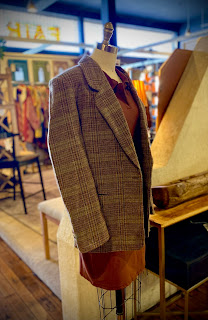I Don't Have Anything To Wear
[Christopher Owens] Austin, thank you so much for talking with me. My family have been big fans of your stores and I’m really pleased to be able to talk with you about your views on clothing and consumerism.
[Austin Storm] It’s my pleasure and thank you for supporting our stores.
[CO] Does Bully For You and The Storm Cellar have an ethos regarding purchasing?
[AS] Yes, we really do. We think that the combination of new and used clothing reflects a significant change in the way people think about clothing and fashion and we are trying to encourage this new way of thinking.
[CO] Have you seen a consumer shift in the acceptance of used clothing?
[AS] Yes, especially adding the vintage label, we now have people from all economic means shopping here. I love when athletes from the university come in specifically looking for vintage clothing that they can’t find elsewhere.
[CO] How do you see the balance between consumer demand for price versus quality and how used clothing fits into this?
[AS] Well, my wife and I started this business because when we were in college we shopped specifically for used clothing because it was the only way we could afford high quality clothing. We think one of the reasons our stores are successful is because others feel the same way.
[CO] This may be a macabre comparison, but I sometimes get concerned that the desire for people to have rescue pets creates a supply incentive for rescue animals. Do you have any similar concerns about rescue or recycled clothing?
[AS] (laughs) Well, yes I definitely do share that concern. I look at it this way, there is no denying that the recycled clothing movement does have an environmental benefit, but it ultimately doesn’t solve the problem. World wide, we are just over producing clothing as well as many other things. We are producing clothing in China for retail sale in the US and then shipping the used versions of these items back to China for vintage sale, it’s just crazy to think about that way.
[CO] You are in a pretty rural area, how do you feel the response to businesses like yours differs in a rural versus urban environment?
[AS] I think we are seeing an entrepreneurial surge in small rural towns happening right now. Colfax is the county seat and used to be where everybody came to shop. The automobile changed that at first and then the internet blew it wide open. But there is a real movement happening right now toward local ownership and local purchasing. And we are excited to be a part of that.
[CO] Austin, thank you so much for sharing your thoughts, vision and this window display with me.
The only true solution to our environmental crisis is globally, locally and personally, we need to find ways to lower our consumption. All efforts at recycling and reusing, while important and noble, are just band aids to the real problems. It is refreshing to know, and acknowledge, that while the big picture solution may seem far away, there are people like Austin and Laura Storm striving to make a difference, in small ways, every day.



Comments
Post a Comment